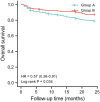Application of integrated management bundle incorporating with multidisciplinary measures improved in-hospital outcomes and early survival in geriatric hip fracture patients with perioperative heart failure: a retrospective cohort study
- PMID: 35067910
- PMCID: PMC9135836
- DOI: 10.1007/s40520-021-02038-z
Application of integrated management bundle incorporating with multidisciplinary measures improved in-hospital outcomes and early survival in geriatric hip fracture patients with perioperative heart failure: a retrospective cohort study
Abstract
Background: In elderly, hip fracture is often complicated by perioperative heart failure, related to worse prognosis. We aimed to analyze the effects of integrated management bundle incorporating with multidisciplinary measures on in-hospital outcomes and early survival in elderly hip fracture patients with perioperative heart failure.
Methods: In this retrospective cohort study, a total of 421 hip fracture patients aged 65 and over who developed perioperative heart failure were included. According to different perioperative management modes applied, patients were retrospectively divided into multidisciplinary management group (Group A), including 277 patients, and integrated management bundle group (Group B), including 144 patients. The B-type natriuretic peptide (BNP) and C-reactive protein (CRP) levels, complications, length of stay, and hospitalization costs were observed and compared between two groups. Overall survival was compared by Kaplan-Meier methods. Cox regression analysis was used to identify prognostic factors associated with overall survival.
Results: A total of 421 patients were enrolled for analysis, including 277 in Group A and 144 in Group B. BNP and CRP levels were significantly decreased compared with admission (P < 0.05). Furthermore, BNP and CRP in Group B decreased much more than those in Group A (P < 0.05). The reductions were observed in length of stay, hospitalization costs and incidence of pulmonary infection, hypoproteinemia, and acute cerebral infarction in Group B (all P < 0.05). The Kaplan-Meier plots showed significantly superior overall survival in Group B. Integrated management bundle was independent favorable prognostic factors.
Conclusions: The integrated management bundle incorporating with multidisciplinary measures significantly improved the therapeutic effect of perioperative heart failure, reduced inflammatory response, and yielded better hospital outcomes. It brought better survival benefits for geriatric hip fracture patients with perioperative heart failure. The results of this study can play an important role in clinical work and provide a valuable theoretical basis for selection of management model in elderly hip fracture patients with perioperative heart failure.
Keywords: Complications; Geriatric; Hip fracture; Management bundle; Perioperative heart failure; Survival.
© 2021. The Author(s).
Conflict of interest statement
The authors declare that there is no conflict of interest regarding the publication of this paper.
Figures
Similar articles
-
Effect of integrated management bundle on 1-year overall survival outcomes and perioperative outcomes in super elderly patients aged 90 and over with hip fracture: non-concurrent cohort study.BMC Musculoskelet Disord. 2022 Aug 15;23(1):778. doi: 10.1186/s12891-022-05720-z. BMC Musculoskelet Disord. 2022. PMID: 35971104 Free PMC article.
-
Establishment and validation of clinical prediction model and prognosis of perioperative pneumonia in elderly patients with hip fracture complicated with preoperative acute heart failure.BMC Surg. 2024 Nov 20;24(1):369. doi: 10.1186/s12893-024-02668-w. BMC Surg. 2024. PMID: 39567977 Free PMC article.
-
Risk factors and characteristics of preoperative heart failure in elderly patients with hip fracture and the influence of anemia on prognosis.BMC Musculoskelet Disord. 2025 Jan 2;26(1):6. doi: 10.1186/s12891-024-08252-w. BMC Musculoskelet Disord. 2025. PMID: 39748385 Free PMC article.
-
Orthogeriatric Management: Improvements in Outcomes during Hospital Admission Due to Hip Fracture.Int J Environ Res Public Health. 2021 Mar 16;18(6):3049. doi: 10.3390/ijerph18063049. Int J Environ Res Public Health. 2021. PMID: 33809573 Free PMC article. Review.
-
Perioperative outcomes in geriatric patients undergoing hip fracture surgery with different anesthesia techniques: A systematic review and meta-analysis.Medicine (Baltimore). 2019 Dec;98(49):e18220. doi: 10.1097/MD.0000000000018220. Medicine (Baltimore). 2019. PMID: 31804347 Free PMC article.
Cited by
-
Elucidating predictors of preoperative acute heart failure in older people with hip fractures through machine learning and SHAP analysis: a retrospective cohort study.BMC Geriatr. 2025 Apr 23;25(1):268. doi: 10.1186/s12877-025-05920-x. BMC Geriatr. 2025. PMID: 40269712 Free PMC article.
-
Implementation of a geriatric care bundle for older adults with acute burns.Burns. 2024 May;50(4):841-849. doi: 10.1016/j.burns.2024.02.022. Epub 2024 Feb 29. Burns. 2024. PMID: 38472006 Free PMC article.
-
Effect of integrated management bundle on 1-year overall survival outcomes and perioperative outcomes in super elderly patients aged 90 and over with hip fracture: non-concurrent cohort study.BMC Musculoskelet Disord. 2022 Aug 15;23(1):778. doi: 10.1186/s12891-022-05720-z. BMC Musculoskelet Disord. 2022. PMID: 35971104 Free PMC article.
-
Characteristics of preoperative atrial fibrillation in geriatric patients with hip fracture and construction of a clinical prediction model: a retrospective cohort study.BMC Geriatr. 2023 May 18;23(1):310. doi: 10.1186/s12877-023-03936-9. BMC Geriatr. 2023. PMID: 37202743 Free PMC article.
-
Incidence and risk factors associated with postoperative surgical site infection in younger adults with hip fractures: a case-control study.Int Orthop. 2022 Dec;46(12):2953-2962. doi: 10.1007/s00264-022-05607-7. Epub 2022 Oct 12. Int Orthop. 2022. PMID: 36222882
References
MeSH terms
Grants and funding
LinkOut - more resources
Full Text Sources
Medical
Research Materials
Miscellaneous




